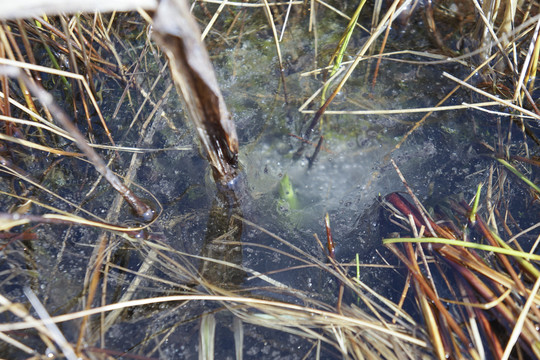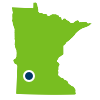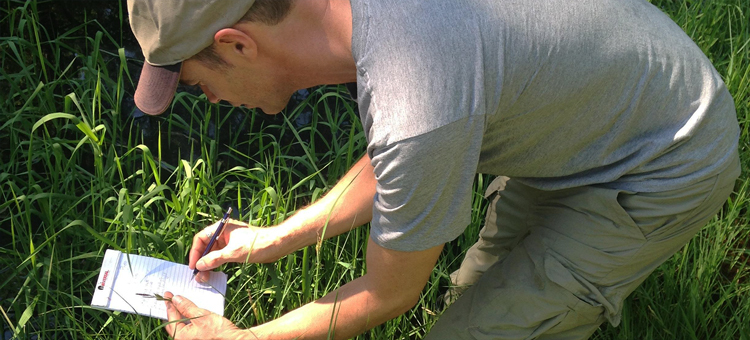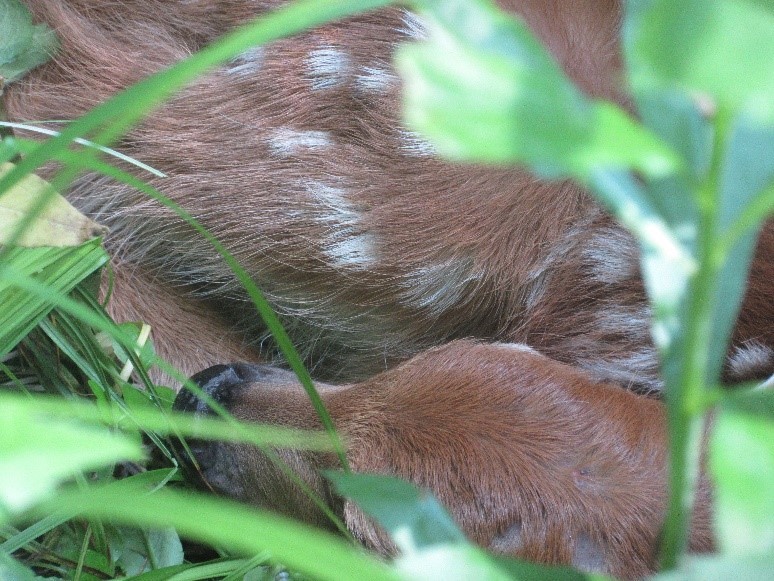Monitoring a Rare Orchid Aids in its Conservation
Fourth in a 50th anniversary story series highlighting natural features preserved on Minnesota Scientific and Natural Areas
Derek Anderson, Minnesota Biological Survey
When someone mentions orchids and their habitat, the imagination may run to plants growing in the trees of a steamy tropical rain forest or swamp. While it is true that many orchids are found in this setting, one can find them in nearly every corner of the world. In fact, Minnesota is home to 49 different species of orchids, including the state flower, the showy lady’s slipper.
An orchid living in a place like Minnesota needs to be well adapted to survive through the changing seasons. In the middle of a temperate continent, orchids survive wild swings in daily temperatures, periods of drought, and months of freezing temperatures in the winter. One example is the western prairie fringed orchid (Platanthera praeclara), a showy prairie orchid found in some of the best remaining wet and mesic prairies of Minnesota (see photo below). This rare species is listed as endangered by the state and is federally listed as threatened. It is also listed as endangered on the International Union for Conservation of Nature’s (IUCN) red list.
The western prairie fringed orchid in flower. Photo by Derek S. Anderson.
Species are rare for a number of reasons. In the case of the western prairie fringed orchid, loss of habitat is one of the major factors that has made this species rare. The Minnesota DNR outlines several other reasons why species become rare in the online Rare Species Guide. The Scientific and Natural Areas program is a critical component in the conservation of this orchid and other rare species in the state.
Each year, the Minnesota Biological Survey studies various aspects of the life history of this species. Our monitoring effort is one of the longest running monitoring programs for a species in the country. Recently, we started looking at the phenology of the western prairie fringed orchid. Phenology is the study of climate and its relationship with biological processes (such as emergence and flowering) over the growing season. Local citizen-scientist volunteers visit the orchids every 10 to 21 days. They record data on variables including its presence, height and floral development of plants. They also photographed their observations over the course of the growing season.
For us, an important aspect of the orchid’s life history was learning when it had emerged from its underground slumber. You may be wondering, “Why is this important?” Well, it turns out that the orchid can be damaged by spring fires that occur after the plants have emerged and started to grow. We wanted to develop tools that could aid land managers and minimize potential negative effects on this rare orchid.
 An emerging orchid in northwestern Minnesota on April 26, 2014. This plant had emerged less than 0.5 cm on this date. Photo by Donna Spaeth.
Our volunteers set out to collect data to help answer this question. Each spring for several years, they walked out on the prairie to sites marked in the previous summer (the orchids are much easier to find when in full flower as opposed to small emerging stems in the spring). They searched for signs of the orchid; documenting any plants observed (photo above). After visiting these places (some of them on SNAs!) for many years, we started to notice some interesting things. For example, typically the first plants that emerge in the spring are flowering individuals. They often are emerging a week or more before their vegetative counterparts. We also discovered that their emergence starts fairly early in the season, often before mid-April. This detailed examination of the western prairie fringed orchid led to an amazing discovery to just how hardy these plants truly are. Unusually warm weather in the spring of 2017 led to plants emerging early. Temperatures then dropped below freezing (photo below). We thought the orchid frozen in ice was surely done. However, much to our surprise, this plant went on to flower later that summer. A true testament to their hardiness!
 An emerged orchid in northwestern Minnesota on March 26, 2017. This plant, estimated to be a few centimeters tall, was frozen in solid ice. This plant did go on to flower. Photo by Donna Spaeth.
We used these data to create an accumulated growing degree-day (GDD) model similar to those used to aid farmers planting their corn. The model provides an estimate on plant emergence and it has helped guide the use of fire for managing sites where this rare plant grows. This is just one example of how the Minnesota Biological Survey collaborates with citizen scientists, academic researchers, the Scientific and Natural Areas Program, and land managers using monitoring data in the conservation of a rare species here in Minnesota.

Site Highlight: Swedes Forest SNA
Brad Bolduan, SNA Region 4 Specialist
Situated south of the Minnesota River on the Redwood/Yellow Medicine County boundary, Swedes Forest SNA may be one of the most visited SNAs in southwest Minnesota. For some the site is familiar because of the state special concern, common five-lined skink (Plestiodon fasciatus) population that resides there. For other visitors it is just a location for a quiet stroll. To a frustrated few of us, it seems to house one of the state’s most persistent populations of the ever too common, common buckthorn. Whatever your reason for visiting the SNA most visitors are amazed by some feature of the site.
One of the most striking features the site offers are the large bedrock knolls. Just a few years ago these hills were essentially shielded from view by dense growths of red cedar. Now that the large trees have been removed, work continues to try to remove the invasive species that persist. Skinks do not seem to be waiting. It seems that they are recolonizing the cleared areas, even as invasive species efforts continue.
|
 The bedrock knolls and oak savanna are two of the key features of this site. Photo by David Minor.
But the site is more than outcrops and skinks. Small wetlands provide habitat for many of the twenty-four species of sedge (Cyperaceae) found during the bioblitz held on the site in 2017. The limited aquatic surveys in the streams and ponds yielded four species of fish and contributed to the 19 species of dragonflies seen that day. A non-comprehensive list of other surveyor’s results includes twenty-six species of spider, five species of reptile, and four species of bat.
Swedes Forest SNA certainly has its battle scars. Quarry holes and associated roads are readily apparent on airphotos taken in 1938. Despite those challenges, and perhaps in part due to some of the management effort that the site has received, it continues to harbor native species - some of them rare. Hopefully, those species will find increased security and better odds of survival as management projects attempt to restore the site to a state resembling its pre-settlement condition. Hopefully, visitors now and many years into the future find a site that helps them imagine the landscape which was present before people depended on photographs. The landscape that the early land surveyors called “Rock Barrens” and all its associated species.
SNA Events
It is summertime! Time to go enjoy the warmth and the sun. Good thing there are plenty of opportunities to get outside on the SNA Events Calendar all summer long! There are volunteering events, educational events, hikes, nature walks, and more! Here is a quick highlight of some of the events coming up, check the website for a more complete list!


Let the experts bend your ear with Prairie Pod podcasts
New episodes of Prairie Pod podcast are coming out this summer! Catch up on episodes from last season where hosts Megan and Jessica talk to natural resource professionals about anything and everything related to Minnesota’s prairies.
Notes from Site Stewards
Site stewards monitor SNAs across Minnesota. Their observations provide valuable information to the SNA Program. Here are some interesting notes from recent reports.
-
During a visit to Pennington Bog SNA on April 28th, new site steward Janet Nelson picked up 3 bags of trash, and located what she believed to be two porcupine dens in the hollows beneath fallen trees about 100 feet apart.
- Levi Plath, the new co-steward at Mound Prairie SNA, visited the site on May 5th, and noted several noteworthy species, including Black-throated Green Warbler, Yellow-rumped Warbler, Palm Warbler, Ovenbird, Whip-poor-will, jeweled shooting star, hoary puccoon, birdfoot violet, and large-flowered bellwort.
-
On May 11th, site steward Angie Begosh, SNA staff and volunteers cut invasive brush at Helen Allison Savanna SNA. The group observed spring wildflowers, a prairie skink, and a ground nest with eggs. The steward and staff are planning to organize monthly events to help maintain the site's oak savanna.
-
Jerry and Karen Ibberson continue their long-term invasive species removal and monitoring rare species stewardship at Clinton Falls Dwarf Trout Lily SNA. On June 2nd, they noted control of invasive dames rocket, seeing a reduction in plants at the SNA.
 A sleeping fawn at Clinton Falls Dwarf Trout Lily SNA. Photo by Jerry and Karen Ibberson.
Thanks stewards for all the work you do for SNAs!

|